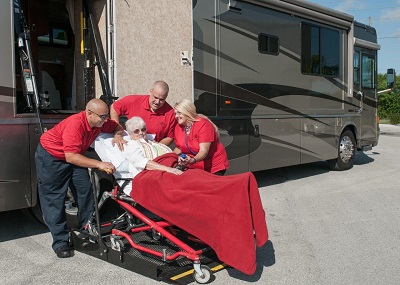A person can live anywhere and the need may arise for medical transport. Systems have grown sophisticated with digital alert bracelets and pendants that notify medical transportation vehicles immediately. Medical transport is provided locally, and abroad. The level of coverage will vary depending upon specifications. Thousands are learning to use medical transcript information to provide patients with important medical transport.
- Vans
- Taxi
- Cars (Mileage reimbursement)
- Small buses (Public transportation)
- Ambulance
Non-emergency Medical Transport:
The medical community makes use of taxis, private cars and ambulance services to help patients travel to and from medical establishments. Utilizing vans, and shuttle buses, patients are transported to appointments at heart care facilities, dialysis, chemotherapy and other patient care need destinations. Patients are also shuttled to dental facilities and general outpatient clinics. In most instances, these transports are non-emergency medical transports, nevertheless, important to the sustaining health of patients.
Groups unrelated to the medical field are venturing into the medical transcript business. Conventional transportation companies are measuring the medical transport business for non-emergency needs and working to make an impact. Pilot programs are operating on the East Coast with the assistance of health care facilities in the areas to pick patients up from their residences; bringing them to hospital appointments. This lowers costs for patients trying to reach medical facilities for doctor’s appointments. These groups are modifying the needs of patients and providing medical transport accordingly.
Ambulance Services:
Equipped with lifesaving devices ambulances are official medical transports. Those driving these vehicles often confer with doctors and other hospital staff while in transports. These vehicles are equipped with trained medical personnel. Mental patients routinely use standard medical transport.
Long Distance Patient Transport:
Those traveling enjoy the comfort of long distance patient transport. Medical planes and helicopters can move patients around the world with the help of medical transcript. Hospital medivac teams routinely move patients from hard to reach locations and offer necessary lifesaving materials brought in by long distance medical transports.
Creating Affordability:
Medical transport is presented in many forms. Thanks to medical transport and transcription, patients are able to obtain medical services through air transport, internationally or locally through pre-arranged insurance coverage. Ambulance fees are as low as $200 in some places and $1200 dollars in others. Cutting cost is possible with the addition of non-emergency medical assistance. Serious cost can be preserved for more serious needs.
Some agents have contracts with insurance companies and the cost is included in the insurance when medical care is unavoidable. The total bill depends on upon care medical transport found necessary to administer. Transportation personnel is connected to hospitals and doctors with many certified in some form of medical training. Income, age or disability placing more patients in need of medical and non-medical transport, as more people become eligible for Medicaid, measures are being set in place for greater participation in medical transport.


